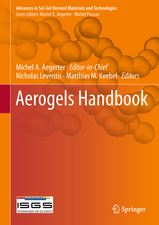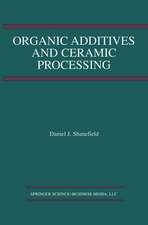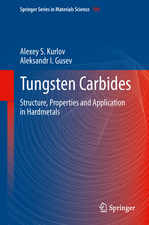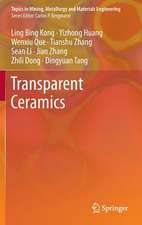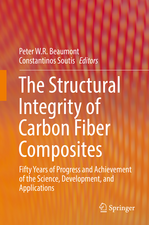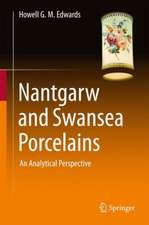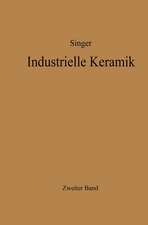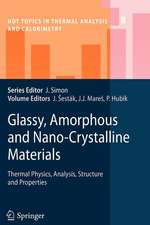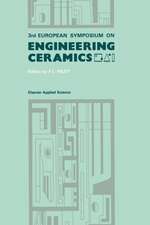Swansea and Nantgarw Porcelains: A Scientific Reappraisal
Autor Howell G.M. Edwardsen Limba Engleză Paperback – 20 iul 2018
| Toate formatele și edițiile | Preț | Express |
|---|---|---|
| Paperback (1) | 682.67 lei 38-44 zile | |
| Springer International Publishing – 20 iul 2018 | 682.67 lei 38-44 zile | |
| Hardback (1) | 791.88 lei 3-5 săpt. | |
| Springer International Publishing – 4 apr 2017 | 791.88 lei 3-5 săpt. |
Preț: 682.67 lei
Preț vechi: 898.24 lei
-24% Nou
Puncte Express: 1024
Preț estimativ în valută:
130.63€ • 136.75$ • 108.09£
130.63€ • 136.75$ • 108.09£
Carte tipărită la comandă
Livrare economică 01-07 aprilie
Preluare comenzi: 021 569.72.76
Specificații
ISBN-13: 9783319840017
ISBN-10: 3319840010
Pagini: 279
Ilustrații: XXXV, 279 p. 106 illus., 104 illus. in color.
Dimensiuni: 155 x 235 mm
Ediția:Softcover reprint of the original 1st ed. 2017
Editura: Springer International Publishing
Colecția Springer
Locul publicării:Cham, Switzerland
ISBN-10: 3319840010
Pagini: 279
Ilustrații: XXXV, 279 p. 106 illus., 104 illus. in color.
Dimensiuni: 155 x 235 mm
Ediția:Softcover reprint of the original 1st ed. 2017
Editura: Springer International Publishing
Colecția Springer
Locul publicării:Cham, Switzerland
Cuprins
Foreword.- Preface.- Prologue: The Origins of Porcelain.- 1 Introduction and Present-Day Scenario.- 2 Porcelain Manufacture in South Wales in the 19th Century. 3 Historical Research Issues.- 4 A Chronological Summary of the Billingsley Family and Their Contribution to Porcelain Manufacture and Decoration.- 5 Burnishing and Gilding.- 6 Commercial Exploitation.- 7 Service Types and the Importance of Nomenclature in Their Attribution.- 8 Armorial Porcelains.- 9 Documentary Porcelain and Historical Provenancing.- 10 The Production of Porcelain Services.- 11 The Scientific Analysis of Porcelain.- 12 Named Artists.- 13 Classification of Factory Output.- 14 Nantgarw Porcelain: Named Services.- 15 Swansea Porcelain: Named Services.- 16 Miscellaneous Named Services.- 17 Conclusions.- 18 The Discovery of a Long-Lost Nantgarw Dinner-Dessert Service.- 19 The Attribution of Unknown Porcelain to Swansea and Nantgarw: A Protocol.- 20 Statement Made by Henry Morris to Colonel Grant Davidson in 1850.- 21 William Billingsley - An Epilogue.- Appendix 1 Notes on the Experimental Production of Swansea Porcelain.- Appendix 2 Transcript of an Interview given by Henry Morris.- Appendix 3 Some Scientific Thoughts on Swansea and Nantgarw Porcelains.- Appendix 4. The Pendock-Barry Service: A Re-Appraisal.- Appendix 5. Detailed Comparison Between the Derby Lord Ongley Service and its Nantgarw Precursors.- Appendix 6. Nantgarw Porcelain – Measurements and Sizes.- Appendix 7. Swansea Script Marks and their Attribution to William Billingsley’s Decoration.- Glossary of Terms Used in this Book.
Notă biografică
Professor H.G.M. Edwards M.A., B.Sc., D.Phil., C.Chem., F.R.S.C. Emeritus Professor of Molecular Spectroscopy, Director of the Centre for Astrobiology and Extremophiles Research , Faculty of Life Sciences , University of Bradford, Bradford BD7 1DP, UK. Honorary Scientific Adviser to The De Brecy Trust for the scientific evaluation and pigment composition of Renaissance and later period paintings.
Howell Edwards studied Chemistry at Jesus College, University of Oxford. Following a Research Fellowship at Jesus College at the University of Cambridge, he took a lectureship in Structural and Inorganic Chemistry at the University of Bradford where he subsequently became Professor of Molecular Spectroscopy and Head of the Chemical and Forensic Sciences Division. In 2003, he received the Sir Harold Thompson Award from Elsevier Science for his international contributions to vibrational spectroscopy. He is the recipient of the Emanuel Boricky Medal for 2008/2009 from Charles University, Prague, for distinguished international contributions to geochemistry and mineralogical analysis. He was awarded the Charles Mann Award from the US Federation of Analytical Chemical Spectroscopic Societies in 2011 for his distinguished international work on the applications of Raman spectroscopy.
In his research career he has published over 1250 papers on Raman spectroscopy and its applications and is the co-editor of five books: “A Handbook of Raman Spectroscopy: From the Research Laboratory to the Process Line” (with IR Lewis, Marcel Dekker, New York, 2001), “Raman Spectroscopy in Archaeology and Art History” (with JM Chalmers, RSC Publishing, Cambridge, 2005), “Selected Topics in Raman Spectroscopic Applications: Geology, Biomaterials and Art” (with F Rull Perez, P Vandenabeele and DC Smith, Publidisa Valladolid, 2007), “ Raman and Infrared Spectroscopy in Forensic Science” (with JM Chalmers and MD Hargreaves, John Wiley & Sons, Chichester, UK, 2012) and“ Selected Topics in Analytical Archaeometry” (with P. Vandenabeele, RSC Publishing, Cambridge, 2012).
Professor Edwards has wide-ranging interests in the applications of Raman spectroscopy to the characterisation of materials particularly in forensic, art historical, astrobiological and archaeological contexts. He is a guest editor and contributing author of the Philosophical Transactions of the Royal Society, the oldest scientific journal in the world. He has been a forerunner in the Raman spectroscopic identification of chemicals produced in biodegradation processes for prehistoric and contemporary systems in an archaeological context — he first investigated the Raman spectra of Dirina lichen colonization of toxic metal substrates on Italian Renaissance wall–paintings in 1991 and has extensively studied the pigments and associated materials involved in paintings from prehistoric cave art to the 20th Century. He is science lead on the European Space agency/Roscosmos ExoMars Raman Laser spectrometer instrument in the Pasteur suite of a planetary rover which will interrogate the Martina surface and subsurface to search for biosignatures and signs of extant and extinct life, scheduled to launch in 2020, with particular responsibility for the interpretation of Raman spectroscopic biosignatures from biogeological niche environments on Mars. He is also UK representative on the ESA/Roscosmos Landing Site Selection Group dedicated to determine where the spacecraft will land on Mars for the deployment of the rover vehicle.
Howell Edwards studied Chemistry at Jesus College, University of Oxford. Following a Research Fellowship at Jesus College at the University of Cambridge, he took a lectureship in Structural and Inorganic Chemistry at the University of Bradford where he subsequently became Professor of Molecular Spectroscopy and Head of the Chemical and Forensic Sciences Division. In 2003, he received the Sir Harold Thompson Award from Elsevier Science for his international contributions to vibrational spectroscopy. He is the recipient of the Emanuel Boricky Medal for 2008/2009 from Charles University, Prague, for distinguished international contributions to geochemistry and mineralogical analysis. He was awarded the Charles Mann Award from the US Federation of Analytical Chemical Spectroscopic Societies in 2011 for his distinguished international work on the applications of Raman spectroscopy.
In his research career he has published over 1250 papers on Raman spectroscopy and its applications and is the co-editor of five books: “A Handbook of Raman Spectroscopy: From the Research Laboratory to the Process Line” (with IR Lewis, Marcel Dekker, New York, 2001), “Raman Spectroscopy in Archaeology and Art History” (with JM Chalmers, RSC Publishing, Cambridge, 2005), “Selected Topics in Raman Spectroscopic Applications: Geology, Biomaterials and Art” (with F Rull Perez, P Vandenabeele and DC Smith, Publidisa Valladolid, 2007), “ Raman and Infrared Spectroscopy in Forensic Science” (with JM Chalmers and MD Hargreaves, John Wiley & Sons, Chichester, UK, 2012) and“ Selected Topics in Analytical Archaeometry” (with P. Vandenabeele, RSC Publishing, Cambridge, 2012).
Professor Edwards has wide-ranging interests in the applications of Raman spectroscopy to the characterisation of materials particularly in forensic, art historical, astrobiological and archaeological contexts. He is a guest editor and contributing author of the Philosophical Transactions of the Royal Society, the oldest scientific journal in the world. He has been a forerunner in the Raman spectroscopic identification of chemicals produced in biodegradation processes for prehistoric and contemporary systems in an archaeological context — he first investigated the Raman spectra of Dirina lichen colonization of toxic metal substrates on Italian Renaissance wall–paintings in 1991 and has extensively studied the pigments and associated materials involved in paintings from prehistoric cave art to the 20th Century. He is science lead on the European Space agency/Roscosmos ExoMars Raman Laser spectrometer instrument in the Pasteur suite of a planetary rover which will interrogate the Martina surface and subsurface to search for biosignatures and signs of extant and extinct life, scheduled to launch in 2020, with particular responsibility for the interpretation of Raman spectroscopic biosignatures from biogeological niche environments on Mars. He is also UK representative on the ESA/Roscosmos Landing Site Selection Group dedicated to determine where the spacecraft will land on Mars for the deployment of the rover vehicle.
Textul de pe ultima copertă
This book describes a holistic study of the porcelain manufactured at Nantgarw and Swansea in the first quarter of the 19th Century, using both scientific analytical data and historical provenancing. This porcelain is acclaimed as some of the finest and most translucent porcelain ever produced. These two porcelain factories are linked through the artistic and creative activities of the enigmatic William Billingsley and had a strictly limited production over only three or four years during the period 1812-1820. The earliest chemical analysis of these porcelains were undertaken almost 100 years ago and are compared with the results of more recent analyses The chemical composition of these porcelains, their artistic decoration and the struggle to maintain quality production is reviewed. Scientific explanations are proposed for the characteristic Swansea duck-egg porcelain translucency and for the Nantgarw iridescence. The book is well illustrated throughout and affords a good basis for the further in-depth study of Swansea and Nantgarw porcelains.
Caracteristici
Describes the rise and fall of the porcelain manufactories of Nantgarw and Swansea in the Regency era Shows that porcelain manufactories can be studied scientifically in a sociological setting involving the artists and personalities associated with the factory productions Much of the porcelain described is now in museum collections worldwide Written by an expert in the field Includes supplementary material: sn.pub/extras

